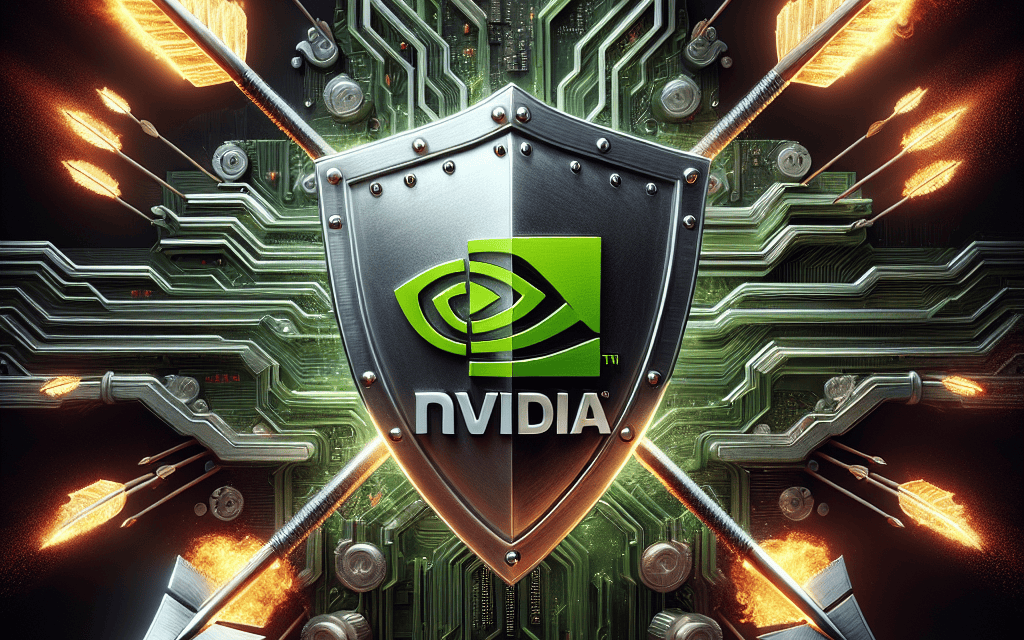“Navigating Tech Titans: Can Nvidia Shield Itself from Super Micro’s Storm?”
Introduction
In the rapidly evolving landscape of technology, companies are constantly navigating a myriad of challenges to maintain their competitive edge and market relevance. Nvidia, a leader in graphics processing and AI computing, faces its own set of hurdles as it seeks to shield itself from the challenges that have beset other tech giants, such as Super Micro Computer. Super Micro has encountered issues ranging from supply chain disruptions to cybersecurity threats, highlighting vulnerabilities that can impact even the most robust organizations. As Nvidia continues to expand its influence across various sectors, including gaming, data centers, and autonomous vehicles, it must strategically address potential risks and fortify its operations. This involves not only advancing its technological innovations but also ensuring resilience against external pressures that could undermine its growth and stability. The question remains: can Nvidia effectively safeguard itself against the multifaceted challenges that have troubled its industry counterparts?
Analyzing Nvidia’s Strategic Position in the Face of Super Micro Computer’s Market Dynamics
Nvidia Corporation, a leader in the graphics processing unit (GPU) market, has long been at the forefront of technological innovation, driving advancements in artificial intelligence, gaming, and data center solutions. However, as the competitive landscape evolves, Nvidia faces new challenges from emerging players like Super Micro Computer, Inc., which is making significant strides in the high-performance computing and server markets. Understanding Nvidia’s strategic position in this dynamic environment requires a comprehensive analysis of its strengths, potential vulnerabilities, and the competitive pressures exerted by Super Micro Computer.
Nvidia’s dominance in the GPU market is largely attributed to its robust research and development capabilities, which have consistently produced cutting-edge products that cater to a wide range of industries. The company’s GPUs are renowned for their superior performance, energy efficiency, and versatility, making them indispensable in sectors such as gaming, professional visualization, and data centers. Moreover, Nvidia’s strategic acquisitions, such as Mellanox Technologies and ARM Holdings, have further solidified its position by expanding its technological portfolio and enhancing its ability to offer integrated solutions.
Despite these strengths, Nvidia must remain vigilant as Super Micro Computer continues to gain traction in the market. Super Micro, known for its high-performance server and storage solutions, has been capitalizing on the growing demand for data center infrastructure. The company’s focus on providing customizable and energy-efficient solutions has resonated with enterprises seeking to optimize their computing environments. As a result, Super Micro has been able to carve out a niche in the market, posing a potential threat to Nvidia’s data center business.
To shield itself from these challenges, Nvidia must leverage its existing strengths while also exploring new avenues for growth. One potential strategy is to deepen its partnerships with cloud service providers and enterprise clients, offering tailored solutions that integrate Nvidia’s GPUs with Super Micro’s server technologies. By doing so, Nvidia can create synergies that enhance the value proposition for customers, thereby mitigating the competitive pressure from Super Micro.
Furthermore, Nvidia can continue to invest in research and development to maintain its technological edge. By pushing the boundaries of GPU capabilities and exploring new applications in artificial intelligence and machine learning, Nvidia can ensure that its products remain indispensable to its core markets. Additionally, expanding its presence in emerging markets, such as autonomous vehicles and edge computing, could provide Nvidia with new revenue streams and reduce its reliance on traditional markets.
In parallel, Nvidia should also focus on strengthening its supply chain resilience. The global semiconductor shortage has highlighted the vulnerabilities in supply chains, and ensuring a steady supply of components is crucial for maintaining market leadership. By diversifying its supplier base and investing in supply chain technologies, Nvidia can better navigate disruptions and maintain its competitive advantage.
In conclusion, while Super Micro Computer presents a formidable challenge, Nvidia’s strategic position remains strong due to its technological prowess, strategic acquisitions, and market leadership. By leveraging its strengths, exploring new growth opportunities, and enhancing supply chain resilience, Nvidia can effectively shield itself from the competitive pressures posed by Super Micro. As the market dynamics continue to evolve, Nvidia’s ability to adapt and innovate will be key to sustaining its leadership in the high-performance computing landscape.
Nvidia’s Technological Innovations: A Shield Against Super Micro Computer’s Competitive Edge
Nvidia Corporation, a leader in the graphics processing unit (GPU) market, has long been at the forefront of technological innovation. Its advancements in artificial intelligence, gaming, and data center solutions have positioned it as a formidable player in the tech industry. However, as the competitive landscape evolves, Nvidia faces challenges from various quarters, including Super Micro Computer, Inc., a company known for its high-performance computing solutions and server technology. The question arises: can Nvidia’s technological innovations serve as a shield against the competitive edge posed by Super Micro Computer?
To understand Nvidia’s position, it is essential to examine the core areas where it excels. Nvidia’s GPUs are renowned for their superior performance in gaming and professional visualization. The company’s focus on AI and machine learning has led to the development of powerful architectures like Ampere and Hopper, which are designed to handle complex computations efficiently. These innovations have not only enhanced Nvidia’s reputation but have also expanded its reach into sectors such as autonomous vehicles and healthcare, where AI-driven solutions are increasingly in demand.
In contrast, Super Micro Computer has carved out a niche in the server and storage market. Its emphasis on energy-efficient, high-performance computing solutions has attracted a diverse clientele, ranging from cloud service providers to enterprise data centers. Super Micro’s ability to offer customizable and scalable solutions gives it a competitive edge, particularly in an era where data-driven decision-making is paramount. As businesses seek to optimize their IT infrastructure, Super Micro’s offerings become increasingly attractive.
Despite these challenges, Nvidia’s strategic initiatives may provide a buffer against the competition. One such initiative is its focus on software development. Nvidia’s CUDA platform, for instance, has become a standard in parallel computing, enabling developers to harness the full potential of Nvidia’s hardware. By fostering a robust ecosystem of software tools and libraries, Nvidia ensures that its hardware remains indispensable to developers and researchers alike.
Moreover, Nvidia’s foray into the data center market with its acquisition of Mellanox Technologies underscores its commitment to expanding its footprint in high-performance computing. This move not only enhances Nvidia’s capabilities in networking and interconnect solutions but also positions it to compete more effectively with companies like Super Micro. By integrating Mellanox’s technology, Nvidia can offer comprehensive solutions that address the growing demands of data-intensive applications.
Furthermore, Nvidia’s investment in research and development is a testament to its dedication to innovation. The company’s substantial R&D budget allows it to explore cutting-edge technologies and maintain its leadership position. This commitment to innovation is crucial in an industry where technological advancements occur at a rapid pace.
In conclusion, while Super Micro Computer presents a formidable challenge with its competitive edge in server technology, Nvidia’s technological innovations provide a robust shield. By leveraging its strengths in GPU technology, software development, and strategic acquisitions, Nvidia is well-positioned to navigate the competitive landscape. As the tech industry continues to evolve, Nvidia’s ability to adapt and innovate will be key to maintaining its leadership and shielding itself from emerging challenges.
Financial Resilience: How Nvidia Can Navigate Challenges Posed by Super Micro Computer
In the rapidly evolving landscape of technology, companies must continuously adapt to maintain their competitive edge. Nvidia, a leader in graphics processing units (GPUs) and artificial intelligence (AI) technologies, faces a unique set of challenges from Super Micro Computer, a company known for its high-performance computing solutions. As Nvidia navigates these challenges, its financial resilience will be crucial in determining its ability to maintain market dominance.
To begin with, Nvidia’s robust financial health provides a solid foundation for addressing competitive pressures. The company has consistently demonstrated strong revenue growth, driven by its innovative product offerings and strategic investments in AI and data centers. This financial strength allows Nvidia to invest in research and development, ensuring that it remains at the forefront of technological advancements. By continuing to innovate, Nvidia can differentiate its products from those of Super Micro Computer, thereby maintaining its competitive advantage.
Moreover, Nvidia’s strategic partnerships and acquisitions play a pivotal role in enhancing its financial resilience. By collaborating with industry leaders and acquiring complementary technologies, Nvidia can expand its product portfolio and enter new markets. These strategic moves not only diversify Nvidia’s revenue streams but also mitigate risks associated with market fluctuations. For instance, Nvidia’s acquisition of Mellanox Technologies has strengthened its position in the data center market, providing a buffer against potential challenges posed by Super Micro Computer’s offerings.
In addition to strategic partnerships, Nvidia’s focus on customer-centric solutions further bolsters its financial resilience. By understanding and addressing the specific needs of its customers, Nvidia can build long-term relationships and foster customer loyalty. This customer-centric approach not only drives sales but also enhances Nvidia’s reputation as a trusted provider of cutting-edge technology solutions. As a result, Nvidia can better withstand competitive pressures from companies like Super Micro Computer, which may not have the same level of customer engagement.
Furthermore, Nvidia’s commitment to sustainability and corporate responsibility enhances its financial resilience by aligning with the growing demand for environmentally conscious business practices. By investing in energy-efficient technologies and reducing its carbon footprint, Nvidia can appeal to environmentally conscious consumers and investors. This commitment to sustainability not only strengthens Nvidia’s brand image but also opens up new opportunities for growth in emerging markets that prioritize green technologies.
However, it is important to acknowledge that Nvidia’s financial resilience is not without its challenges. The company must navigate the complexities of global supply chains, which can be affected by geopolitical tensions and trade restrictions. To mitigate these risks, Nvidia can diversify its supply chain and explore alternative sourcing strategies. By doing so, Nvidia can ensure a steady supply of components and maintain its production capabilities, even in the face of external disruptions.
In conclusion, Nvidia’s financial resilience is a key factor in its ability to navigate the challenges posed by Super Micro Computer. Through strategic investments, customer-centric solutions, and a commitment to sustainability, Nvidia can maintain its competitive edge and continue to thrive in the dynamic technology landscape. While challenges remain, Nvidia’s strong financial foundation and proactive approach position it well to shield itself from competitive pressures and capitalize on new opportunities for growth. As the technology industry continues to evolve, Nvidia’s ability to adapt and innovate will be crucial in securing its long-term success.
Exploring Nvidia’s Supply Chain Strategies to Mitigate Risks from Super Micro Computer’s Growth

Nvidia, a leader in the graphics processing unit (GPU) market, has long been at the forefront of technological innovation, driving advancements in artificial intelligence, gaming, and data centers. However, as the company continues to expand its influence, it faces new challenges from emerging competitors like Super Micro Computer. Super Micro, known for its high-performance computing solutions, has been gaining traction in the market, posing potential risks to Nvidia’s supply chain and market dominance. To navigate these challenges, Nvidia must employ strategic supply chain management practices that not only mitigate risks but also ensure sustained growth and competitiveness.
One of the primary strategies Nvidia can adopt is diversifying its supplier base. By relying on a broader range of suppliers, Nvidia can reduce its dependency on any single entity, thereby minimizing the impact of disruptions. This approach not only enhances supply chain resilience but also fosters competitive pricing and innovation among suppliers. Furthermore, Nvidia can leverage its strong market position to negotiate favorable terms with suppliers, ensuring a steady flow of components necessary for its cutting-edge products.
In addition to diversification, Nvidia can invest in building stronger relationships with its existing suppliers. By fostering collaboration and open communication, Nvidia can gain better insights into potential supply chain disruptions and work proactively to address them. This collaborative approach can also lead to joint innovation efforts, where Nvidia and its suppliers co-develop new technologies that can give both parties a competitive edge. Such partnerships can be particularly beneficial in the rapidly evolving tech landscape, where staying ahead of the curve is crucial.
Moreover, Nvidia can explore vertical integration as a means to exert greater control over its supply chain. By acquiring or investing in key suppliers, Nvidia can ensure a more reliable supply of critical components while also benefiting from cost efficiencies. Vertical integration can also facilitate faster innovation cycles, as Nvidia would have direct access to the production processes and technologies of its suppliers. However, this strategy requires careful consideration of the associated risks and costs, as it involves significant capital investment and potential regulatory hurdles.
Another important aspect of Nvidia’s supply chain strategy is the adoption of advanced technologies to enhance supply chain visibility and efficiency. By implementing data analytics, artificial intelligence, and blockchain technologies, Nvidia can gain real-time insights into its supply chain operations, enabling more informed decision-making. These technologies can help identify potential bottlenecks, optimize inventory management, and improve demand forecasting, ultimately leading to a more agile and responsive supply chain.
Furthermore, Nvidia must remain vigilant in monitoring the competitive landscape and adapting its strategies accordingly. As Super Micro Computer continues to grow and potentially disrupt the market, Nvidia should continuously assess its competitive positioning and explore opportunities for strategic alliances or collaborations. By staying attuned to industry trends and competitor movements, Nvidia can proactively adjust its supply chain strategies to maintain its market leadership.
In conclusion, while Super Micro Computer’s growth presents challenges to Nvidia, the company has several strategic options to mitigate these risks. Through supplier diversification, strengthened partnerships, potential vertical integration, and the adoption of advanced technologies, Nvidia can enhance its supply chain resilience and maintain its competitive edge. By remaining agile and proactive in its approach, Nvidia can continue to thrive in the dynamic tech industry, ensuring its position as a leader in innovation and market influence.
Nvidia’s Market Diversification: A Key to Withstanding Super Micro Computer’s Industry Impact
Nvidia, a titan in the semiconductor industry, has long been synonymous with cutting-edge graphics processing units (GPUs) and innovative technology solutions. However, as the industry landscape evolves, Nvidia faces new challenges, particularly from companies like Super Micro Computer, which are making significant strides in the market. To navigate these challenges, Nvidia’s strategy of market diversification emerges as a crucial factor in maintaining its competitive edge and ensuring its resilience.
In recent years, Super Micro Computer has gained traction by offering high-performance computing solutions that cater to a wide range of industries, including data centers, cloud computing, and artificial intelligence. This expansion has positioned Super Micro as a formidable competitor, capable of impacting the market dynamics that Nvidia has traditionally dominated. As a result, Nvidia must adapt to these changes by leveraging its strengths and exploring new avenues for growth.
One of Nvidia’s primary strategies for diversification involves expanding its product offerings beyond traditional GPUs. By venturing into areas such as artificial intelligence, autonomous vehicles, and data center solutions, Nvidia is not only broadening its market reach but also reducing its reliance on any single product line. This approach allows Nvidia to tap into emerging markets and capitalize on the growing demand for advanced computing solutions. For instance, Nvidia’s advancements in AI technology have positioned it as a leader in machine learning and deep learning applications, which are increasingly integral to various industries.
Moreover, Nvidia’s strategic partnerships and acquisitions play a pivotal role in its diversification efforts. By collaborating with industry leaders and acquiring companies with complementary technologies, Nvidia can enhance its product portfolio and accelerate innovation. These partnerships enable Nvidia to integrate cutting-edge technologies into its offerings, thereby strengthening its position in the market. For example, Nvidia’s acquisition of Mellanox Technologies has bolstered its capabilities in high-performance computing and data center networking, providing a competitive edge in these critical areas.
In addition to product diversification, Nvidia’s focus on research and development (R&D) is instrumental in maintaining its industry leadership. By investing heavily in R&D, Nvidia can stay ahead of technological advancements and anticipate market trends. This commitment to innovation ensures that Nvidia remains at the forefront of the industry, capable of delivering state-of-the-art solutions that meet the evolving needs of its customers. Furthermore, Nvidia’s emphasis on R&D fosters a culture of continuous improvement, enabling the company to adapt swiftly to changing market conditions.
While Nvidia’s diversification strategy is a key factor in withstanding the challenges posed by Super Micro Computer, it is also essential for the company to remain vigilant and responsive to industry shifts. By closely monitoring market trends and customer demands, Nvidia can identify new opportunities for growth and adjust its strategies accordingly. This proactive approach will enable Nvidia to not only shield itself from competitive pressures but also thrive in an increasingly dynamic industry landscape.
In conclusion, Nvidia’s market diversification strategy is a critical component of its ability to withstand the challenges presented by Super Micro Computer’s industry impact. By expanding its product offerings, forging strategic partnerships, and investing in research and development, Nvidia is well-positioned to navigate the evolving market landscape. As the industry continues to transform, Nvidia’s commitment to innovation and adaptability will be essential in maintaining its competitive edge and ensuring its long-term success.
The Role of Strategic Partnerships in Strengthening Nvidia Against Super Micro Computer’s Advances
In the rapidly evolving landscape of technology, strategic partnerships have become a cornerstone for companies seeking to maintain a competitive edge. Nvidia, a leader in graphics processing units (GPUs) and artificial intelligence (AI), finds itself in a dynamic environment where competitors like Super Micro Computer are making significant advances. To fortify its position, Nvidia has increasingly turned to strategic partnerships as a means of bolstering its capabilities and expanding its influence across various sectors.
One of the primary advantages of strategic partnerships is the ability to leverage complementary strengths. Nvidia, renowned for its cutting-edge GPU technology, has formed alliances with companies that offer expertise in areas where it seeks to expand. For instance, collaborations with cloud service providers such as Amazon Web Services and Microsoft Azure have enabled Nvidia to integrate its AI capabilities into cloud platforms, thereby reaching a broader audience and enhancing its service offerings. These partnerships not only extend Nvidia’s reach but also provide a robust infrastructure that supports its technological innovations.
Moreover, strategic partnerships facilitate access to new markets and customer bases. By aligning with industry leaders in different sectors, Nvidia can tap into established networks and customer relationships. This approach is particularly beneficial in industries such as automotive and healthcare, where Nvidia’s AI technology can be applied to autonomous vehicles and medical imaging, respectively. Through partnerships with companies like Mercedes-Benz and Siemens Healthineers, Nvidia is able to introduce its technology to new applications, thereby diversifying its portfolio and reducing reliance on traditional markets.
In addition to market expansion, strategic partnerships also foster innovation through collaborative research and development. By working closely with other technology leaders, Nvidia can accelerate the development of new products and solutions. Joint ventures and co-development projects allow for the sharing of resources, knowledge, and expertise, leading to breakthroughs that might not be achievable independently. This collaborative approach not only speeds up the innovation process but also mitigates risks associated with research and development, as costs and uncertainties are shared among partners.
Furthermore, strategic partnerships can enhance Nvidia’s competitive positioning by creating synergies that are difficult for competitors like Super Micro Computer to replicate. By forming alliances with companies that have unique capabilities or technologies, Nvidia can create integrated solutions that offer superior performance or functionality. These synergies can result in differentiated products that stand out in the marketplace, providing Nvidia with a competitive advantage that is not easily challenged.
However, it is important to recognize that strategic partnerships are not without challenges. Aligning goals and expectations between partners requires careful negotiation and management. Additionally, maintaining a balance between collaboration and competition is crucial, as partners may also be competitors in certain areas. Despite these challenges, the benefits of strategic partnerships often outweigh the drawbacks, particularly in an industry where innovation and adaptability are key to success.
In conclusion, as Super Micro Computer continues to advance, Nvidia’s reliance on strategic partnerships serves as a vital strategy to shield itself from competitive pressures. By leveraging complementary strengths, accessing new markets, fostering innovation, and creating synergies, Nvidia can strengthen its position and continue to thrive in a rapidly changing technological landscape. Through these partnerships, Nvidia not only enhances its current capabilities but also positions itself for future growth and success.
Nvidia’s R&D Investments: Building a Fortress Against Super Micro Computer’s Technological Threats
Nvidia, a titan in the semiconductor industry, has long been at the forefront of technological innovation, particularly in the realms of graphics processing units (GPUs) and artificial intelligence (AI). As the company continues to expand its influence, it faces increasing competition from various quarters, including Super Micro Computer, a company known for its high-performance computing solutions. In this competitive landscape, Nvidia’s substantial investments in research and development (R&D) serve as a critical strategy to maintain its competitive edge and shield itself from the technological threats posed by rivals like Super Micro Computer.
To understand the significance of Nvidia’s R&D investments, it is essential to consider the rapidly evolving nature of the technology sector. The demand for more powerful and efficient computing solutions is ever-increasing, driven by advancements in AI, machine learning, and data analytics. Nvidia has recognized this trend and has consistently allocated a significant portion of its revenue to R&D. This commitment not only fuels innovation but also ensures that Nvidia remains at the cutting edge of technology, capable of delivering products that meet the complex needs of modern computing.
Moreover, Nvidia’s R&D efforts are not limited to incremental improvements in existing technologies. The company is also focused on pioneering new frontiers, such as the development of AI-driven solutions and the exploration of quantum computing. By investing in these emerging fields, Nvidia is positioning itself to capitalize on future technological shifts, thereby creating a robust defense against competitors who may seek to challenge its market dominance. This forward-thinking approach is crucial in an industry where the ability to anticipate and adapt to change can determine a company’s success or failure.
In addition to exploring new technologies, Nvidia’s R&D investments are also directed towards enhancing its existing product lines. For instance, the company has made significant strides in improving the performance and efficiency of its GPUs, which are widely used in gaming, professional visualization, and data centers. By continuously refining these products, Nvidia not only meets the current demands of its customers but also sets new standards for the industry, making it difficult for competitors like Super Micro Computer to match its offerings.
Furthermore, Nvidia’s strategic partnerships and collaborations with leading research institutions and technology companies amplify the impact of its R&D investments. These alliances enable Nvidia to access a broader pool of knowledge and resources, facilitating the development of innovative solutions that address complex challenges. By leveraging these partnerships, Nvidia can accelerate its R&D efforts and bring cutting-edge products to market more quickly, thereby maintaining its competitive advantage.
While Super Micro Computer poses a formidable challenge with its focus on high-performance computing solutions, Nvidia’s comprehensive R&D strategy provides a strong foundation for countering this threat. By investing in both current technologies and future innovations, Nvidia is building a fortress that not only protects its market position but also propels it forward in the ever-evolving technology landscape. As the company continues to navigate this competitive environment, its commitment to R&D will undoubtedly play a pivotal role in determining its long-term success.
In conclusion, Nvidia’s substantial investments in research and development are a testament to its dedication to innovation and excellence. By focusing on both enhancing existing technologies and exploring new frontiers, Nvidia is well-equipped to shield itself from the challenges posed by competitors like Super Micro Computer. As the technology sector continues to evolve, Nvidia’s R&D strategy will remain a critical component of its efforts to maintain its leadership position and drive future growth.
Q&A
1. **What are the main challenges faced by Super Micro Computer?**
– Super Micro Computer faces challenges such as supply chain disruptions, intense competition in the server market, and geopolitical tensions affecting global trade.
2. **How does Nvidia’s business model differ from Super Micro Computer’s?**
– Nvidia primarily focuses on designing GPUs and AI hardware, while Super Micro Computer specializes in manufacturing and selling server and storage solutions.
3. **What strengths does Nvidia have that could shield it from similar challenges?**
– Nvidia’s strengths include a strong brand reputation, leadership in GPU technology, a diverse product portfolio, and strategic partnerships in AI and gaming sectors.
4. **How does Nvidia manage supply chain risks?**
– Nvidia manages supply chain risks through strategic supplier relationships, diversified manufacturing locations, and maintaining inventory buffers.
5. **What role does innovation play in Nvidia’s strategy to mitigate challenges?**
– Innovation is central to Nvidia’s strategy, with continuous investment in R&D to develop cutting-edge technologies and maintain a competitive edge.
6. **Can Nvidia’s focus on AI and gaming help it avoid challenges faced by Super Micro Computer?**
– Yes, Nvidia’s focus on AI and gaming provides growth opportunities and market differentiation, potentially insulating it from challenges specific to the server market.
7. **What external factors could still pose risks to Nvidia despite its strengths?**
– External factors such as global economic downturns, regulatory changes, and shifts in consumer demand could still pose risks to Nvidia.
Conclusion
Nvidia, a leader in the GPU market, faces challenges similar to those encountered by Super Micro Computer, particularly in supply chain vulnerabilities, geopolitical tensions, and competitive pressures. However, Nvidia’s robust market position, diversified product offerings, and strategic partnerships provide it with a stronger buffer against these challenges. By continuing to innovate and expand into new markets such as AI and data centers, Nvidia can mitigate risks and maintain its competitive edge. Nonetheless, it must remain vigilant and adaptable to external pressures to shield itself effectively from similar challenges faced by Super Micro Computer.





